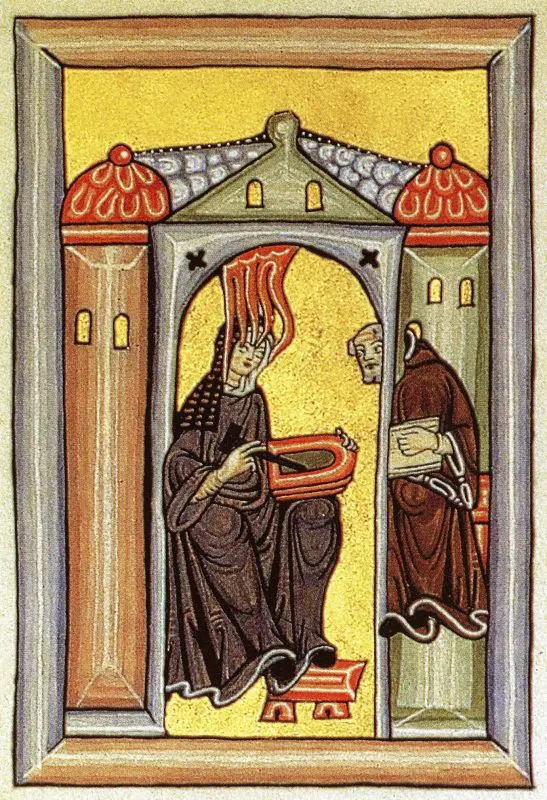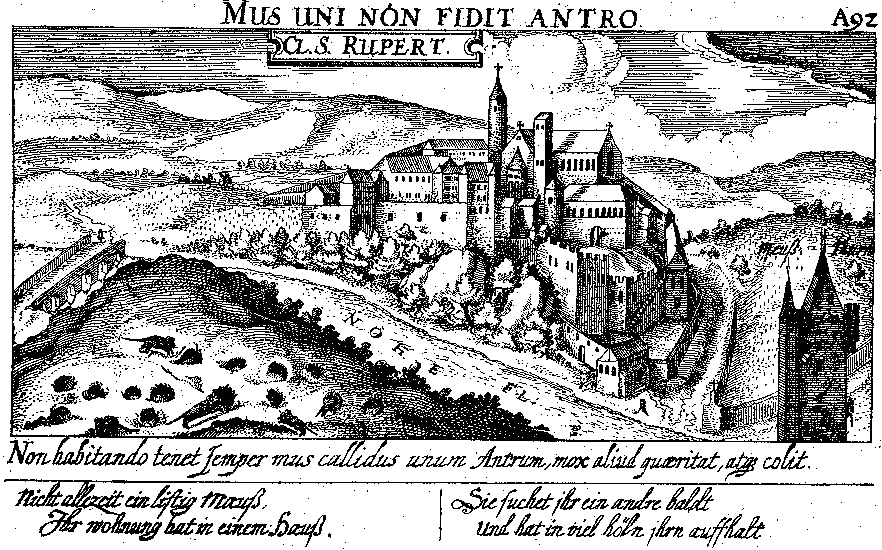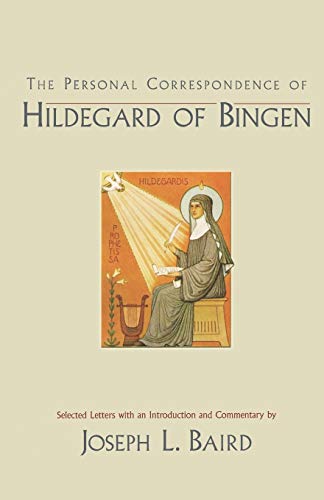St Hildegard of Bingen officially holds the title of Patron Saint of Writers and Composers (and some suggest she’s unofficially the patron saint of both Beer and of Women, especially those of a certain age). Beyond the trappings of Sainthood, Hildegard was most certainly an extraordinary woman. The Benedictine Abbess was a Polymath who received visions from God, wrote books about Science and Nature, wrote music used in the church, corresponded and gave consultation to Kings, Queens, and Bishops, invented her own language, painted, started her own Abbey (against the will of the Benedictine Monks), traveled extensively in Europe on a speaking/preaching tour, was placed under interdict and venerated, and is thought to be the reason we put hops in beer. That’s quite a resume for a woman of the 1100s.
St Hildegard of Bingen
Sometime in 1098, Hildegard was born, the tenth child of a wealthy family. In the custom of the time, she was “tithed” to the church. (A tithe is a donation to the church of 10% of your income. As the 10th child, Hildegard was promised to the church.) When she turned 8, Hildegard’s parents turned her over to Jutta, an anchorite of the Benedictine monastery in Disibodensberg.
(quick aside- An anchorite is defined as a religious recluse, but unlike a Hermit, an anchorite lives in a small room sealed off from the world. The only window leads into the church so she can participate in services and receive food. The days are spent in religious contemplation and embroidery. Interestingly, anyone becoming an anchorite is given “last rights” before being sealed in, as they are considered dead to the world.)
Jutta von Sponheim had modest fame in her own way. Her religious fervor and asceticism drew other pupils, as well as Hildegard. She taught them basic reading and writing, Canonical hours (official church prayers), and how to play the psaltery (a stringed instrument that looks a little like a harpsichord or an autoharp without keys.) When Jutta died in 1136, the other pupils, now nuns, elected Hildegard as their convent. (Think about that for a second… she was bricked into the monastery for 30 YEARS… the only contact with the world was a screened window into the church and a pass-through for food. Over time, others joined them).
 Hildegard and Volmar – Visions from God- Public Domain
Hildegard and Volmar – Visions from God- Public Domain
Visions from God
Hildegard started receiving visions from God at age 3, but she told no one except Jutta and a monk named Volmar. (At the time, many people were making religious claims, causing splinters in the church. Her strong faith kept her from disclosing anything that might be considered problematic.) Then, in 1141 (at age 42), Hildegard claimed God sent a strong vision that gave her an instant understanding of religious texts. He also commanded her to write the visions down. Still, she was troubled.
“But although I heard and saw these things, because of doubt and low opinion of myself and because of diverse sayings of men, I refused for a long time a call to write, not out of stubbornness but out of humility, until weighed down by a scourge of god, I fell onto a bed of sickness. “
When Hildegard finally got out of bed, she resolved to get approval from the Church. Her letter went to St Bernard, who passed the correspondence along to Pope Eugenius. The pope gave his consent and encouragement. So, with Volmar acting as secretary, she started writing. Her first work, Scivias (“Know the Ways of the Lord”), hit the medieval equivalent of the Best-Seller Lists… and Hildegard’s fame spread across Germany and beyond.
She followed up with other divine books, Libervitae Martorium (Book of Life’s Merits) and Liber Divinorum Operum (Book of Divine Works)

Medieval depiction of a spherical earth with different seasons at the same time (from the book “Liber Divinorum Operum”). Public Domain
Hildegard Starts her own Convent
“Women may be made from man, but no man can be made without a woman”
By 1150, Hildegard and her nuns felt constrained living at the Benedictine Monastery. Hildegard claimed that God told her she no longer required the supervision of men and that building the new Abbey was his order. She found the perfect location, bought land using the Dowry money that the wealthy girls under her care brought in, and began construction in Rupertsberg, near Bingen.
(Before we go further… let’s consider the time frame in relation to what else was going on at that time. Frederick I became King of Germany in 1152, then Holy Roman Emperor in 1155. Munich in the South and the Hanseatic League in the North would not be founded for another 8 years, 1158. And it was incredibly unusual that a woman would have so much political power and wealth at that time.)

Monastery Rupertsberg, Germany during 30 Years war- public domain
Over time, Rupertsberg grew to a population of 50 women. They mostly came from wealthy families, bringing money in with them to maintain their accustomed lifestyle. They wore comfortable white gowns and left their hair down and flowing. Think of the Abbey more like a finishing school than a Convent.
Then, as the convent outgrew its walls, Hildegard founded another convent at Eibingen.
Hildegard the Writer
St Hildegard of Bingen spent much of her time writing and corresponding with religious leaders and heads of State all over Europe. Over 300 of these letters still survive, including letters to four different Popes (some with a distinctly chiding tone over policy disputes), Henry II and Eleanor of Aquitaine in England, Abbots and Abbesses to explain her visions, and she even lectured Frederick Barbarossa for supporting the Anti-Pope. People wrote to her about everything from clarification of scriptures to political insight.
Hildegard had serious issues with the Holy Roman Emperor. She felt his Ecclesiastical appointments overstepped the Pope’s authority and blatantly insulted him in a letter. “…[I]n a mystic vision, I see you like a little boy or some madman living before Living Eyes. Yet you still have time for ruling over worldly matters. Beware, therefore, that the almighty King does not lay you low because of the blindness of your eyes, which fail to see correctly how to hold the rod of proper governance in your hand. See to it that you do not act in such a way that you lose the grace of God” (Letter #45, p.78). Ironically, when Barbarossa attacked Rome in 1166 to put his Anti-Pope on the papal seat, he and his troops were struck by incapacitating sickness. (I’m sure it was just a coincidence.) Imagine the sheer guts! Taking on the Holy Roman Emperor!)
But it wasn’t merely correspondence.

The Universal Man, Liber Divinorum Operum of St. Hildegard of Bingen, 1165- Public Domain
A typical Polymath, Hildegard of Bingen’s writings showed off her knowledge of a wide range of subjects.
She wrote 77 poems with accompanying music, the Symphonia Armonie Celestium Revelationum [Symphony of the Harmony of Celestial Revelations]. She claimed that music was invented to worship God properly and wrote hers to reflect what Angels sound like. (You can enjoy a recorded piece of her music here)
“The word is living, being, spirit, all verdant greening, all creativity. The word manifests itself in every creature”
People still refer to her Natural History and Medicine volumes and consider her book Physica Causae et Curae, a cornerstone of Western herbal medicine. This incredibly detailed book details the curative powers of natural objects, everything from plants and animals to minerals and metals. The volume included drawings and illustrations. Imagine the time it must have taken to collect and test everything. Another book, Liber Subtilatum (The Diverse Nature of Things), clarifies her belief that man was God’s greatest creation and that all things were put on earth for man to use. Even more “shocking” for its time, Hildegard wrote about gynecology, women’s health issues, and sexual relations.
Hildegard made four major tours, traveling extensively in the German empire and sharing her visions and explanations. She was a ROCK STAR.
And if that wasn’t enough, she invented her language and alphabet, Lingua Ignota (Latin for ‘unknown language’).
St Hildegard of Bingen and Beer
Brewers worldwide give thanks to Hildegard and consider her responsible for the beer we enjoy today. She is regarded as the first to scientifically describe hops, writing, “Hops stop putrefaction when put in beer, and it may be added so that it lasts longer.” Hildegard also points out that hops will increase melancholy, but anyone who has hung out in a bar after midnight knows this. Additionally, ingesting barley (presumably in beer) benefits the stomach and intestines.
Some say that her daily ration of Hoppy Beer allowed her to live such a long life, and she did live to age 81, which is admirable when you consider the average lifespan of the time was 35.
Feisty to the End
Nearing the end of her life, Hildegard got into trouble when she allowed a wealthy noble who had been excommunicated (kicked out of the church) to be buried in the Rupertsberg cemetery. The church ordered that the body be exhumed. But Hildegard insisted that God allowed the burial and had the grave hidden. Church authorities responded by putting her community under interdict, meaning they couldn’t participate in many church rites, including, and most frustrating for Hildegard, singing. She appealed and won.

Hildegard von Bingen. Line engraving by W. Marshall.
Hildegard von Bingen, “The Sibyl Of The Rhine,” died in 1179 at age 81 and was buried under the alter of her convent at Rupertsberg. In 1632, during the Thirty Years War, the Swedish (Protestant) army destroyed Rupertsberg, and the nuns escaped to Eibingen, carrying the shrine with Hildegard’s remains. Today, you can still visit Hildegard’s coffin at the working Abbey at Eibingen.
2012 Pope Benedict XVI officially declared St Hildegard von Bingen “perennially relevant.” He made her a Saint through the process of “equivalent canonization,” which is a papal proclamation of canonization based on a standing tradition of popular veneration (my understanding is that this means they made her a saint because everyone already thought she was). A few months later, he bestowed her the title Doctor of the Church (to clarify, a Doctor of the Church is not a medical doctor; in this case, a doctor means a teacher). The writings of any Doctor of the Church are considered recommended Doctrine that is true, timeless, and of importance to the Church. Only 36 Saints have been given this title, and Hildegard of Bingen is one of only four women to receive the honor.
St Hildegard of Bingen crammed a lot of Living into her 81 years. She did it all while enjoying her hoppy beer every day.
Want to Learn MORE?
There are hundreds of books about every aspect of St Hildegard of Bingen’s life and works. There are CDs so you can enjoy her music and Cookbooks to prepare foods she may have enjoyed. You can enjoy books with her art, visions, correspondence, and even children’s books about this amazing woman.
She’s also the subject of Mary Sharratt’s fiction novel, “Illuminations: A Novel of Hildegard of Bingen.” (I highly recommend this entertaining historical fiction that gives you a sense of what life must have been like for Hildegard.)
Hildegard von Bingen: A Journey into the Images Hildegard von Bingen’s Physica: The Complete English Translation of Her Classic Work on Health and Healing
Hildegard von Bingen’s Physica: The Complete English Translation of Her Classic Work on Health and Healing Illuminations of Hildegard of Bingen
Illuminations of Hildegard of Bingen The Personal Correspondence of Hildegard of Bingen (Letters of Hildegard of Bingen)
The Personal Correspondence of Hildegard of Bingen (Letters of Hildegard of Bingen) HILDEGARD OF BINGEN: A Saint for Our Times: Unleashing Her Power in the 21st Century
HILDEGARD OF BINGEN: A Saint for Our Times: Unleashing Her Power in the 21st Century Hildegard of Bingen: Scientist, Composer, Healer, and Saint
Hildegard of Bingen: Scientist, Composer, Healer, and Saint From Saint Hildegard’s Kitchen: Foods of Health, Foods of Joy
From Saint Hildegard’s Kitchen: Foods of Health, Foods of Joy Hildegard of Bingen
Hildegard of Bingen Hildegard von Bingen: A Feather on the Breath of God
Hildegard von Bingen: A Feather on the Breath of God











For more on Hildegard, her influence, and ongoing projects, the International Society for Hildegard von Bingen Studies was founded in 1983
http://www.hildegard-society.org/p/home.html
I have also read that she was an avid herbalist and fasted to stay healthy. Thanks for this post, I found it quite interesting!
Do we know if Albertus Magnus read her writings ?
My wife’s middle name is Hildegard. She saw a book about the one from Bingen and learned some. She also said thqt a few days ago she recalled her again, so this came at a good time.
I’m glad… she was such a fascinating woman. What a great namesake!